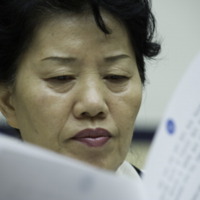
In the labor camp, we were forced to do all kinds of heavy labor work, including planting grass and trees, clearing garbage, digging cellars for storing vegetables in winter, knitting sweaters, knitting cushions, making toys, producing disposable syringes, wrapping sanitized chopsticks and so on. Most of the products were for export. In particular, the sweaters we knitted were large sizes only suitable for foreigners who are big in build. In February 2001, we received an order for 100,000 toy rabbits…The rabbits were about 30 cm long, brown in color, with a long neck, wearing a large bright red collar made from fleecy material, with two black whiskers on each side of the face, about five-six cm long. Some of the rabbits wore cowboy vests, some wore dustcoats, and some had one eye patched up like a pirate. There were English letters on their chests, with their fists clenched, thumbs up. There were three toes on their feet, canary yellow in color. Their tails were white in color and very short.
Usually the toy rabbits for processing were delivered to the labor camp by a middle-aged woman riding a tricycle. The steps we did included: flip over the rabbit which had already been stitched from inside, stuff the man-made cotton wool into the back, neck, ears, the 5-petal small flower on the head, and collar. Thread a soft steel wire into the ears, stitch together the back and collar, sew on the whiskers, use thread to stitch the mouth so as to make the gaping mouth close a little bit. Sew the eyes to make it more firm, glue on the eyebrows, use thread to shape the fingers and toes on the hands and feet. (The hands and feet of the half-made product are in one piece; we used threads to pull back parts of the hand and foot tightly, so the dent looks like a finger groove). Stitch on the tail, stick alphabets on the chests, etc. The tools used to stick the eyebrows and the alphabets on the chests look like a hot air gun. Except for the processes of sticking the eyebrows and the alphabets and stitching on the tails, I did all the other steps. The ears, five-petal small flower and collar were separate from the body when they came to us. We stuffed man-made cotton wool into them. After filling the ears, we flipped them over and threaded a soft steel wire (or aluminum wire) into them.
The rabbit’s collar is a circular loop, the diameter is about four-five cm. After stuffing in man-made cotton wool, it is directly sewn onto the rabbit from the outside with red thread. This is the first time I learnt this method of sewing in the labor camp. The thread is pulled after sewing and the two sides will appear very even. You cannot see any traces of the stitching. This method is also used to sew the rabbit’s body from the back (if you can get hold of a rabbit and carefully pull it open, you can also see if a certain section of its collar and the section slightly above its back is sewn together using this method). Before sewing it up, it is first stuffed with man-made cotton wool. There is a wire in the body of the rabbit (slightly thicker than that in its ears, the wire seems to be two-ply, all the way through to the back of its head).
The whiskers are made using black nylon strings one mm thick. This kind of nylon string is about 50 cm long before being cut up for making the whiskers. It is threaded through a needle which is stuck into one side of the rabbit’s cheeks through underneath its nose and out from the other cheek, leaving a five-six cm long nylon string at the beginning spot where the needle was pricked into, thus forming the rabbit’s whiskers. Then the nylon string is knotted so that it does not move and it is threaded back to the other cheek and cut off. The string is cut off so that it is around one cm shorter than the one above. After making the whiskers on one side, the two whiskers on the other cheek are completed using the same method. When the nylon string in the needle is used up, another is threaded in and the process is continued.
It would go through over 30 processing lines to make a rabbit like this, and it would take over ten hours to make one. But the processing fee for each rabbit was only 30 cents. The processing fees were paid to the labor camp. We didn’t get anything. Usually we began work after getting up at five o’clock in the morning, and worked until two or three o’clock in the morning the next day. Sometimes we had to work overtime, otherwise we could not finish the job. At the busiest time, I did not dare to wash my hands after going to the toilet, in order to save a few minutes. At night, sometimes I was so exhausted that I could not even count clearly from one to nine. Yet I still had to force my eyes open to knit sweaters. The pattern of the sweater was quite complicated; sometimes we finally finished the knitting after much effort only to discover the next morning it had been knitted completely wrongly. So, we had to unpick the stitches and redo it. Long hours of highly intensive workload and severe lack of sleep made me feel, for a very long period of time, that the only thing I needed in my life was sleep.
Narrative as told to the US Congressional-Executive Commission on China, June 22, 2005, in Washington DC.


